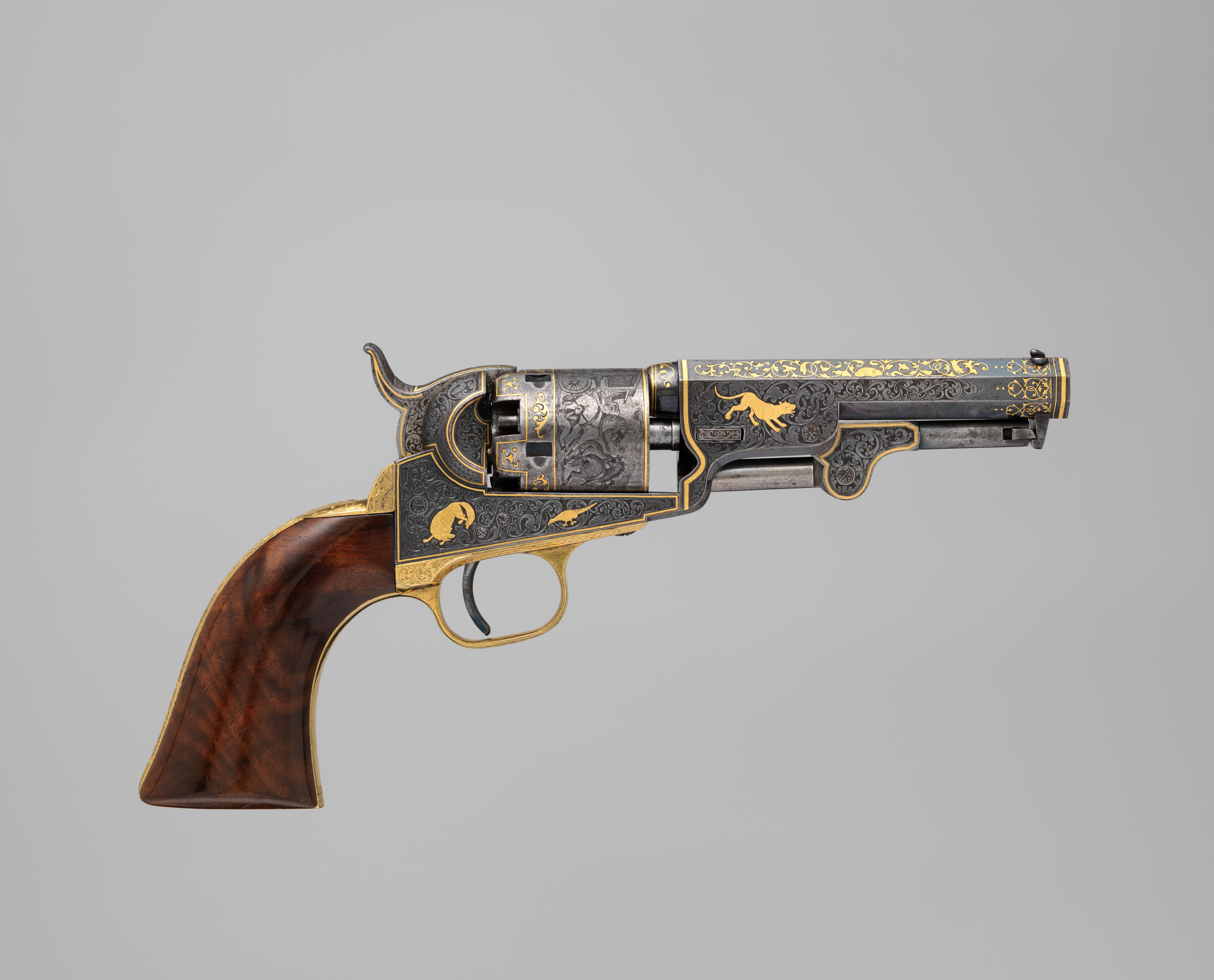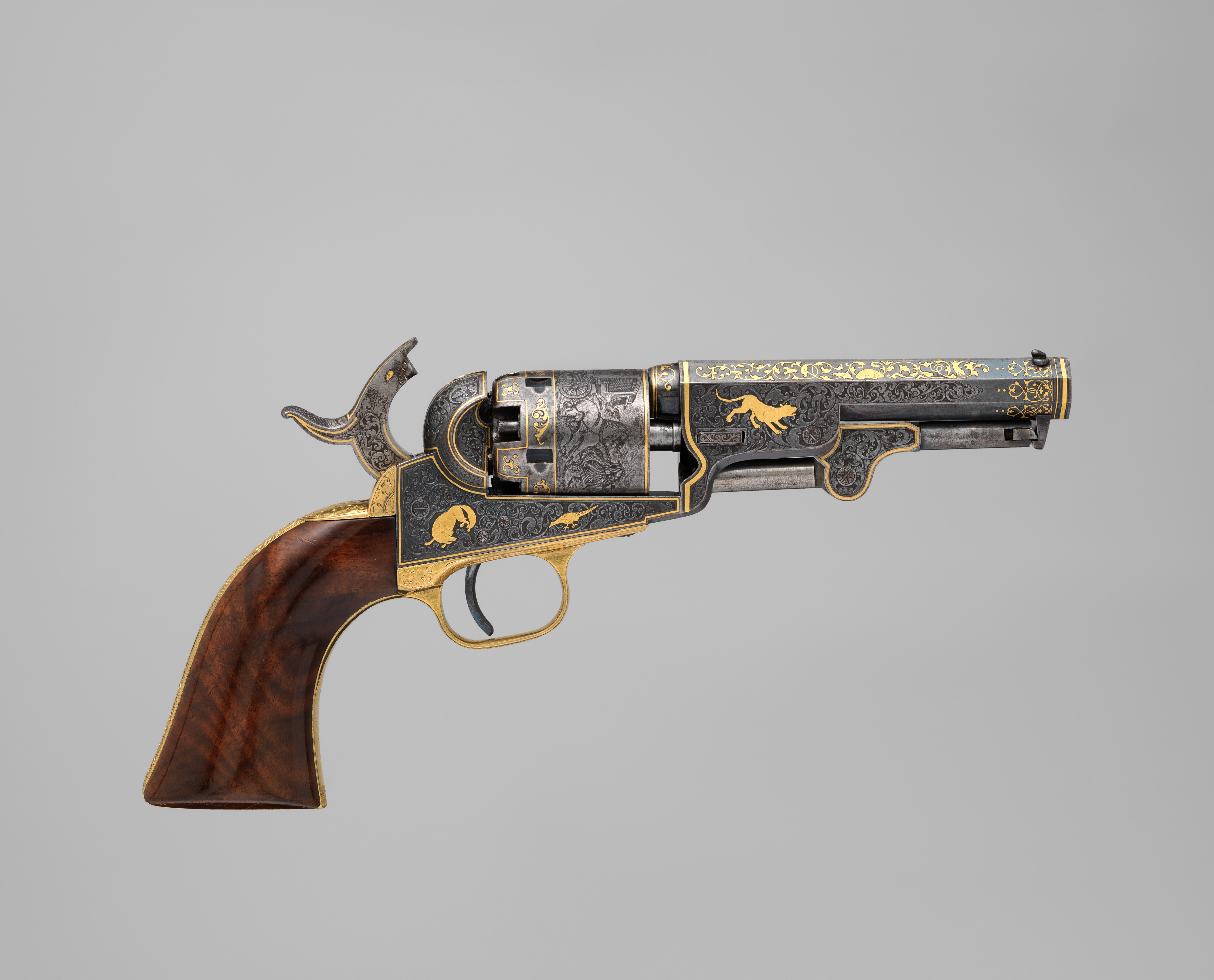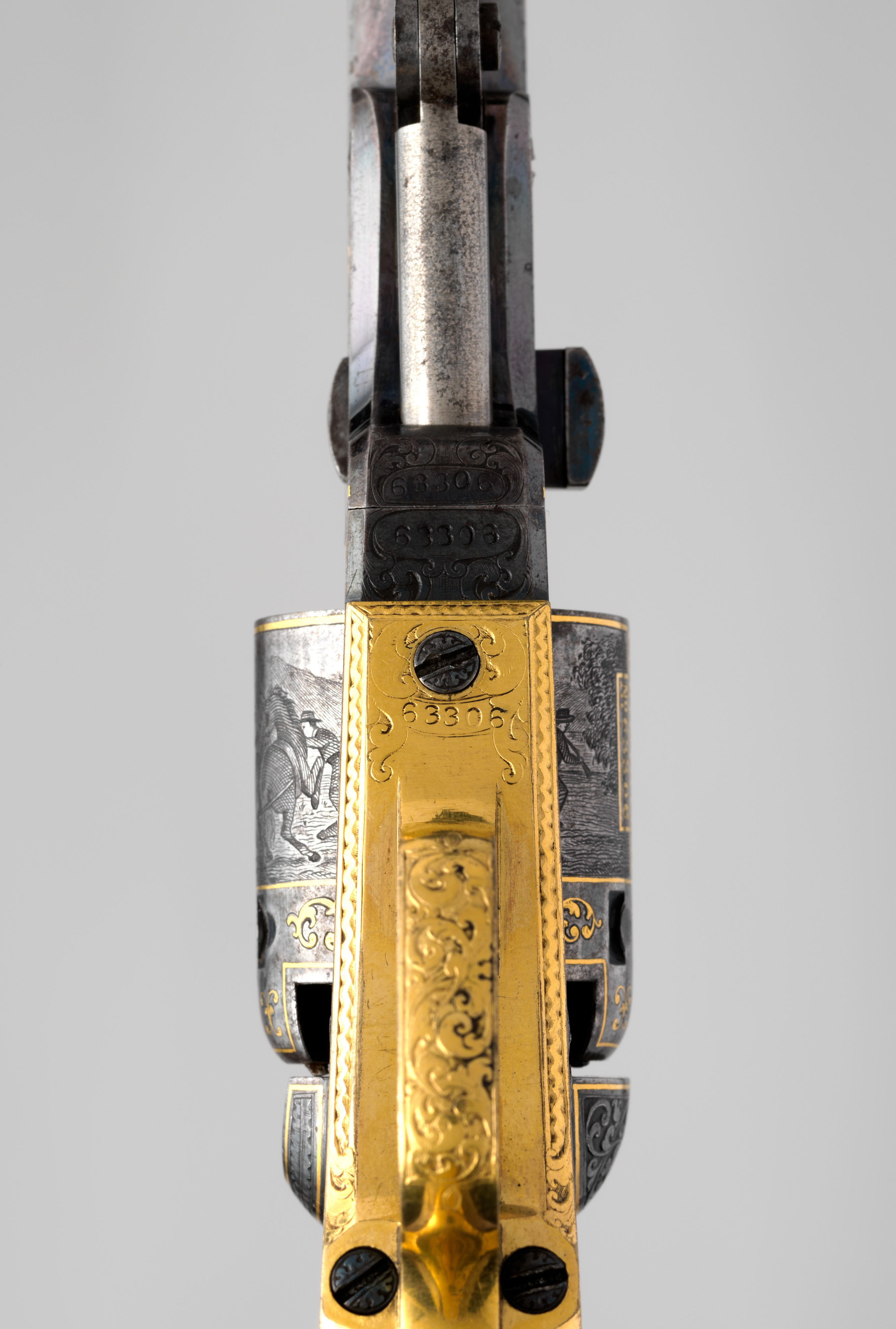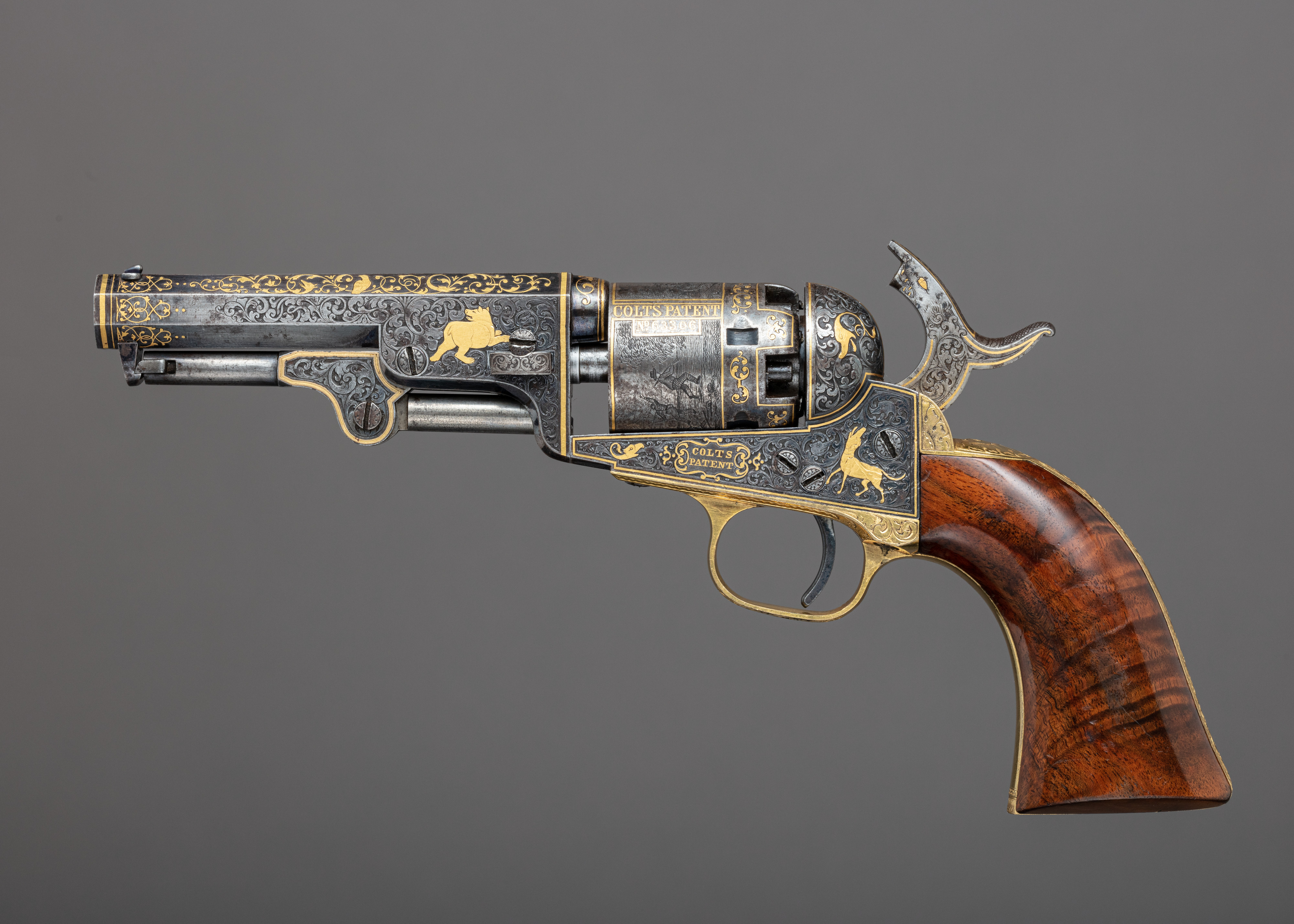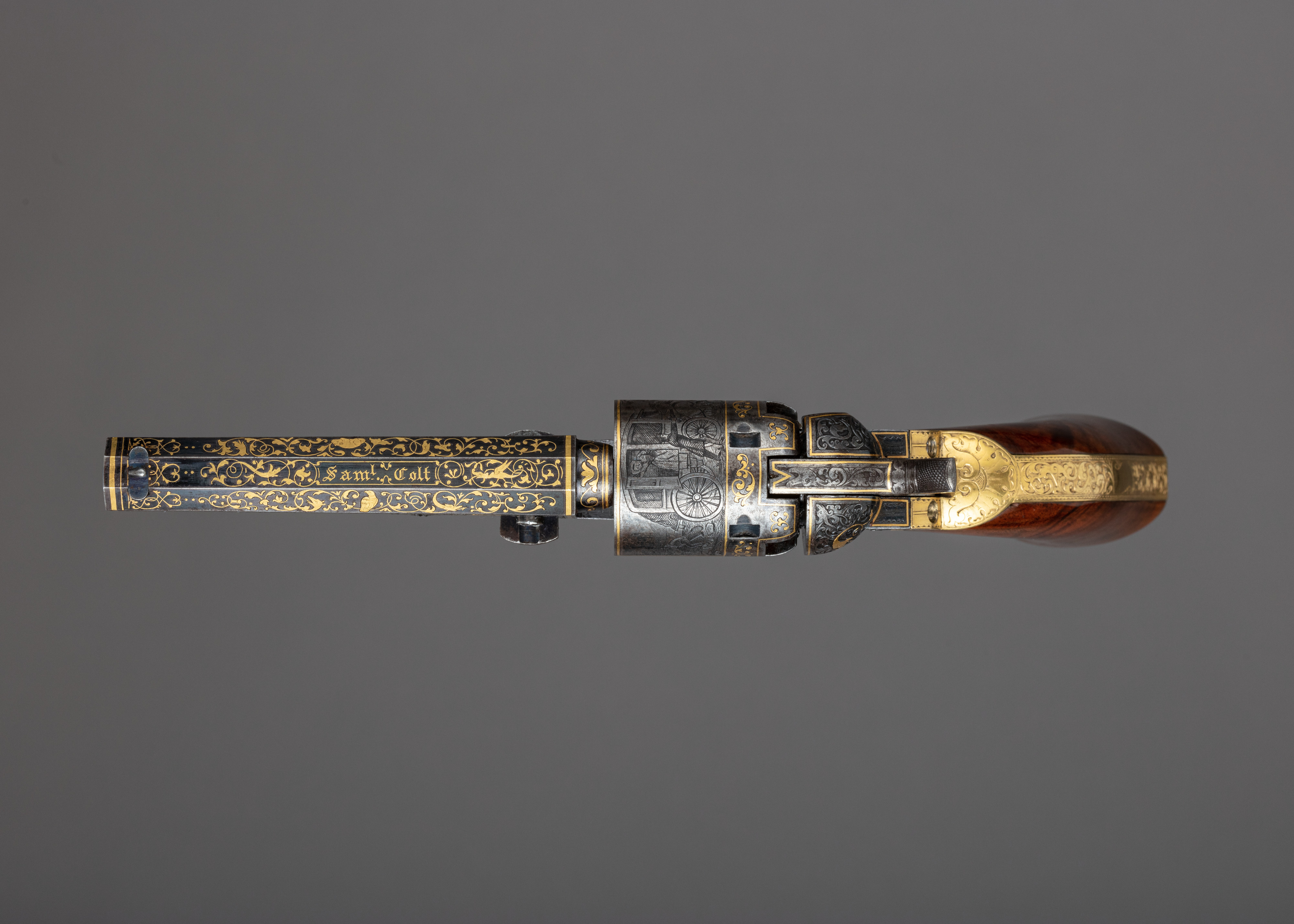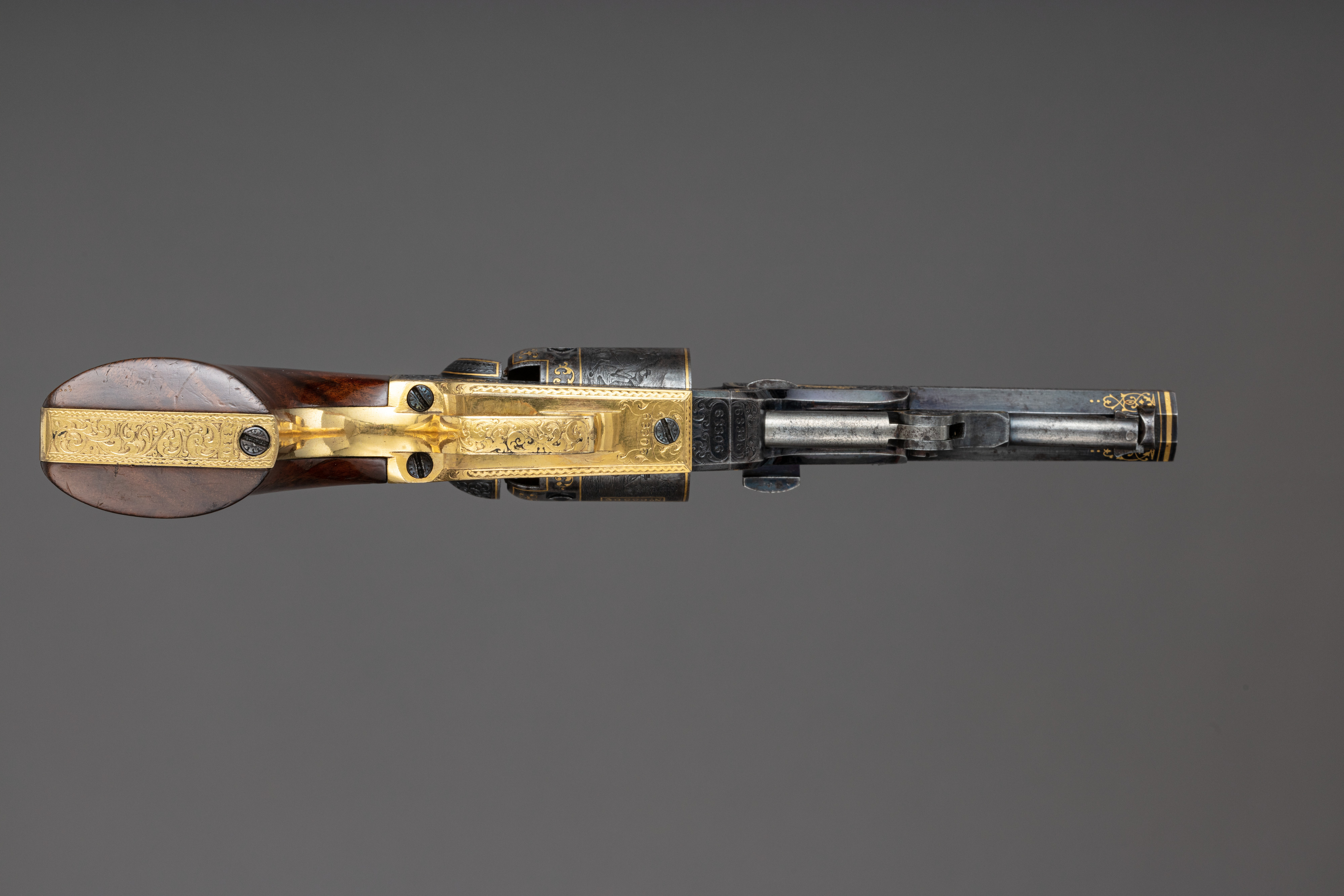Gold-inlaid Colt Model 1849 Pocket Revolver (serial no. 63306)
Manufacturer Samuel Colt American
cylinder ornament: Waterman Lilly Ormsby American
This Model 1849 Pocket Revolver belongs to a rarefied group of Colt percussion firearms decorated with profuse engraving, relief carving, and flush or low relief gold inlay, of which about twenty examples are known to survive. Made at Samuel Colt’s (1814–1862) direction for exhibition at international fairs and for presentation to important officials and foreign and domestic heads of state, including the kings of Sweden and Denmark and the Czar of Russia, they functioned as diplomatic gifts and demonstrations of the company’s artistic and technical achievements.
The pistol is one of two gold-inlaid Colts donated by The Robert M. Lee Foundation to The Met in honor of the Museum’s 150th anniversary (see also acc. no. 2018.856.2a–o). The revolvers rank among the most significant additions to the Museum’s American firearms collection in decades due to their great rarity as a type, the richness of their decoration, and their historical significance.
The American gunmaker, inventor, industrialist, and entrepreneur Samuel Colt redefined the technology and manufacture of firearms in the mid-nineteenth century, inventing innovative revolvers with interchangeable parts and elegant, durable designs. He also pioneered effective and sometimes controversial new methods of publicizing and promoting his products, utilizing celebrity endorsements, seeking out armed conflicts around the world and marketing weapons to opposing sides simultaneously, and harnessing consumers’ attentiveness to aesthetics by designing his firearms to be visually appealing, giving them attractive forms and variously blued, case-hardened, and polished steel finished, sometimes inlaid and elaborately engraved.
Colt displayed his firearms at international fairs, including the Great Exhibition of 1851 in London and New York’s Exhibition of the Industry of All Nations in 1853. He also made gifts of his products, usually decorated examples, to powerful individuals in positions to purchase or retail his firearms in quantity or influence their sale, and over the course of his lifetime, hundreds of pistols were given away by Colt, his company, and his family, to these ends. The small group of gold-inlaid pistols made during Colt’s lifetime, of which the Museum’s pocket pistol is one example, represent the apex of this category of exhibition and presentation Colt firearms.
The revolver’s serial number (63306) follows in sequence that of another gold-decorated Model 1849 revolver (63305), one of three gold-inlaid pistols Colt presented to Czar Nicholas I at Gatchina Palace on October 30, 1854, preserved in the State Hermitage Museum in St. Petersburg. The two other gold-inlaid pistols presented to the Czar are a Third Model Dragoon revolver (12407) and Model 1851 Navy revolver (20131). The two Colt pistols long considered mates to these revolvers are in The Metropolitan’s collection (12406 and 20133, respectively) (acc. nos. 1995.336 and 2018.856.2a).
The Museum’s gold-inlaid pistols’ history as exhibition or presentation pieces in the mid-nineteenth century remains undocumented, absent firm historical records like those which survive for the Hermitage group (See Wilson and Tarassuk, The Russian Colts, 1979), and because, in part, like nearly all other gold-inlaid Colt pistols, including the Hermitage group, the Museum’s revolvers do not feature dedicatory inscriptions. Many of Colt’s more modest presentation revolvers are inscribed with the name of the recipient on the backstrap.
The Museum’s pocket pistol is one of six known gold-inlaid Model 1849 revolvers. The serial numbers and locations of the other five revolvers are as follows: 63271 [private collection]; 63303 [Autry Museum of the American West, Los Angeles]; 63305 [State Hermitage Museum, St. Petersburg]; 67498 [private collection]; 71746 [Connecticut State Library]. Each is uniquely decorated with engraved scrollwork and five of the pistols feature gold-inlaid animal motifs. Like the other Model 1849 pistols in this group, the scrollwork on the Museum’s pistol frame and barrel assembly is relief carved as opposed to engraved so that it stands proud of the background—a feature that, in addition to the pistol’s gold accents, distinguishes it from the hundreds of finely engraved presentation firearms produced by the company.
The scrollwork tendrils decorating the Museum’s pistol terminate in animal heads and are interspersed with seven gold inlaid and engraved animals: a fox, pheasant, leopard, bear, dog, eagle, and wolverine (?). The author of the scrollwork and gold inlay (and possibly the cylinder engraving) on this pistol and indeed all gold-inlaid firearms made during Colt’s lifetime has remained a topic of debate among scholars for decades, with Gustave Young (1827–1895), Herman Bodenstein (1829–1865), and John Marr (1831–1921) emerging as possible candidates. Young engraved for Colt from 1853–58, Bodenstein from 1852–55 and 1856–65, and Marr from 1853–55.
The cylinder is hand-engraved with the standard stagecoach robbery scene found on factory-decorated Model 1849 pocket revolvers of this period, though on typical Model 1849s the image is roll-engraved. The scene was designed by Waterman Lilly Ormsby (1809–83), an engraver with specialization in bank notes who worked for Colt since at least 1839. In addition to the stage coach robbery scene, Ormsby also designed for Colt the equally iconic cavalry and naval battle scenes roll-engraved on the cylinders of factory-decorated Holster and Belt Model Pistols. These designs became so well-known that the Holster and Belt revolvers became officially and popularly known as the Dragoon and Navy pistols, respectively.
Though much of the pistol’s original deeply blued surface finish has faded, traces of bluing are still visible, particularly on the top flats of the barrel near the muzzle and in the recesses of the cylinder.
The Model 1849 Pocket Pistol, introduced in 1848 and remaining in production until 1872, was one of Colt’s most popular firearms with more than 300,000 produced. Available with four-, five-, or six-inch barrels, its small size made it practical pistol for self-defense—a point its cylinder scene was intended to demonstrate, with the driver defending himself and his passenger and property with a pistol.
This pistol is one of four gold-inlaid Colt firearms in The Metropolitan’s collection. The others include the aforementioned Third Model Dragoon revolver (12406) (acc. no. 1995.336) and Model 1851 Navy revolver (20133) (acc. no. 2018.856.2a), and a Model 1862 Police Revolver (38549) (acc. no. 2014.699) made ca. 1868, after Colt’s death. The collection also includes a pull from a Colt Dragoon frame believed to have been taken from a lost gold-inlaid revolver (acc. no. 2009.330).
Due to rights restrictions, this image cannot be enlarged, viewed at full screen, or downloaded.
This artwork is meant to be viewed from right to left. Scroll left to view more.


